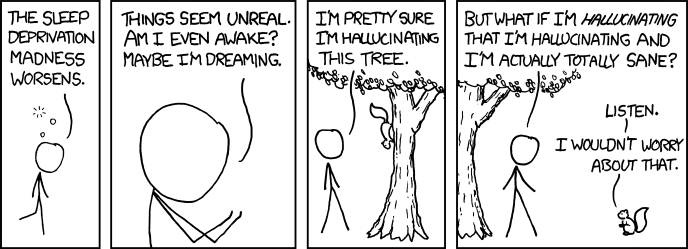Why Sleep?
Sleep is a mysterious activity. All animals that have been tested so far, from the simplest invertebrates to the highest mammals, have shown to possess – and to require – the fundamental characteristics of sleep, independently of the size or the complexity of their nervous systems. In all animals, sleep is a vital necessity, as chronic sleep deprivation leads to a still-unexplained death.
Most animals sleep for a considerable fraction of their life. The molecular basis of sleep regulation also seems to be strongly conserved as most species respond in the same way to many hypnotic drugs or wake-stimulants. This remarkable conservation across evolution suggests that the core function of sleep has to be sought at the basic cell biological level of neuronal function, namely that sleep is an intrinsic requirement of any neuronal network and, possibly, every neuron (or even cell?). Yet, so far, most of the efforts in investigating the function of sleep have been focused on the electrophysiological analysis of the sleeping brain in a very descriptive fashion. We know a great deal about the electrical correlates of sleep and wakefulness but this knowledge could not, by itself, shed any light on the function of sleep.
Our goal is to tackle the problem from a different perspective, using a combination of genetics, molecular biology, engineering, and bioinformatics.
Why flies?
What are the genes and the anatomical connections that regulate sleep? What happens in a single neuron when asleep? What are the molecular connections between sleep and learning and memory? Over the last century, Drosophila has proved to be the favourite animal model for studying the genetics of relatively complex neurobiological problems: for instance, many of the molecules involved in learning and memory have been identified in flies; the entire genetics of circadian regulation was discovered and characterised in Drosophila (and got awarded a Nobel prize in 2017. One of the six that flies received so far). It is therefore reasonable to predict that flies can contribute to the unsolved mystery of sleep as much as they did in other puzzling fields. If the choice of fruit flies as an animal model for neuroscience sounds puzzling to you, I would recommend venturing into this book.
Novel approaches.
Sleep in Drosophila is a relatively new field. When it started, in the early 2000s, it relied on tools developed for studying circadian rhythms that were not created and meant to study sleep. They were an excellent second best to start but we could better. We invested several years in developing new technological approaches to study sleep in flies. We wrote and maintain a rather popular software to monitor and analyse sleep in invertebrates and we are regularly working on this front (see lab github). To study not just sleep but behaviour tout-court we developed Ethoscopes, a hardware suite with unique capabilities and rethomics, a software package to go with it. We are also exploring novel approaches to study and quantify sleep in humans and other species, such as cornu aspersum, commonly known as “garden snails”.
What we found so far and what we are working on.
We are working to challenge some of the dogma that – for whatever reason – we have taken for granted so far. In particular, we showed that:
- Animals that virtually do not sleep do exist and they carry a normal life with no consequences on their longevity (Geissmann et al 2019 – well explained in this article on the NYT)
- Homeostatic drive contributes only marginally to sleep pressure. Most of the drive actually comes from the circadian clock (Geissmann et al 2019)
- Sleep pressure is forgivable and regulated in hierarchies like any other biological drive. That means that there are circumstances in which an animal will not feel the need to recover loss sleep! (Beckwith et al 2017)
- Flies, like humans, can process qualitative information during sleep. Like a human who is able to recognise their own name being called during sleep, a fly can recognise an important odour and distinguish it from a less-salient one (French et al 2021)
- Sleep appearance tends to be a rather conserved evolutionary trait among Drosophilds but not so its regulation, both at the molecular and behavioural way! That implies that sleep evolution could be convergent and therefore emphasis the behavioural characteristics of sleep over its molecular underpinnings (French and Joyce et al, in preparation)
- Based on all the above, we postulated a new hypothesis of sleep function that we call “a tripartite hypothesis“: sleep is not a monolythic feature of the organism and it is composed of three aspects. A fundamental component (fullfilling a basic biological property; a useful component (helping us fullfill some non-strictly fundamental biological properties); an accessory component (whose role is to keep us asleep in the safety of our nest and out of troubles!) See the video below for a nice description of this model.
Working in the lab.
We are always looking for enthusiastic and skilled Biology, Biochemistry, or engineering students willing to carry their MRes or MSc rotation research in my lab. Inquiries from prospective PhD, BSc, MRes, Erasmus or simply visiting students from abroad are also welcome but highly competitive. If you have any interest please feel free to drop an email, after having read this. Funded positions are advertised on the lab webpage when available.
Funding.
Research in the lab is currently funded by Imperial College London, BBSRC, EPSRC, Cancer Research UK. We are also funded through industry collaborations, with Syngenta and Betabugs.
In the past, we have been funded by Royal Society (2011), EPSRC (2013), EMBO (2016), Edmond J. Safra Foundation(2014), Marie Curie (2016), The Gas Safety Trust(2018), and a private philanthropic donation from College Alumni.
See also: Lab Members, Publications, Protocols, The laboratory book.

